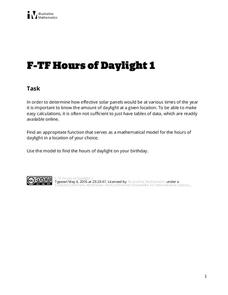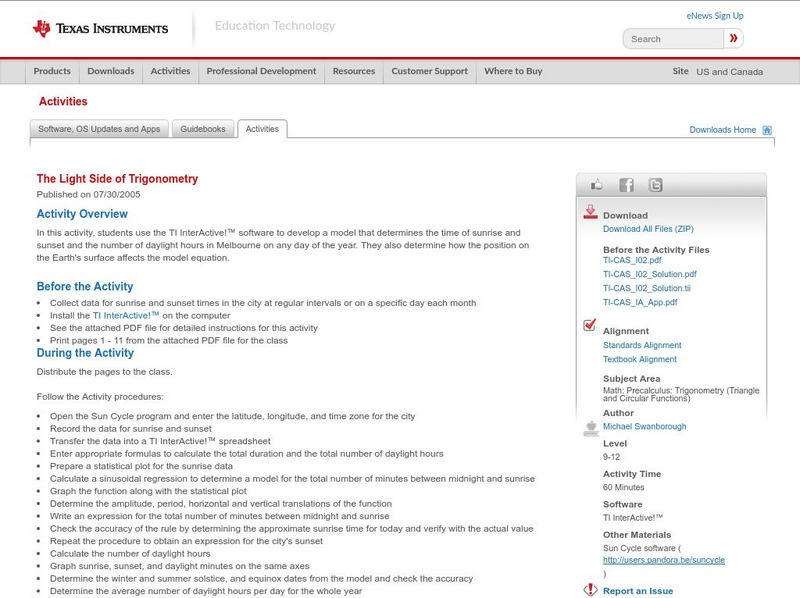Curated OER
What Goes Up Must Come Down!!
Fifth graders look at actual sunrise and sunset times for their hometown to determine a pattern in the amount of daylight. They collect their data in Excel and create a chart to help them identify the pattern, then write an explanation...
Curated OER
Sunrise, Sunset
What locations on Earth get the longest number of hours of daylight in the summer? Hint: It's not the equator! Use real-world sunrise and sunset data to develop trigonometric models that can be used to estimate the number of hours of...
Illustrative Mathematics
Hours of Daylight 1
The midline of the mathematical model of the number of hours of sunlight is not 12 hours. Pupils use the modeling cycle to determine a function that will model the number of hours of sunlight at a location of their choosing. Using...
Curated OER
Sunrise/Sunset
Students apply data from a weather-related website to predict patterns in the sunrise and sunset.
Curated OER
Time Zones
In this time zones worksheet, students are given a map of the Earth indicating the time zones, the prime meridian and the international date line. Students answer 5 questions about solar occurrences and determine when each would be seen...
Curated OER
Time Zones in the United States
Eighth graders explore how to use the time zones in the United States and internationally. They use elapsed time to solve problems. Students calculate the time in various places in the United States. They discuss the 6 time zones in the...
Curated OER
Time and Time Again
Students analyze the effects of time zone differences on how we function as a global community, focusing particularly on the turn of the millennium as a way for students to calculate time zone differences.
Curated OER
Time Zone Math
In this algebra learning exercise, students calculate the different time of the day that different countries see the sun. They convert between different time zones. There are 3 questions with an answer key.
Curated OER
Tell Time With Your Feet
Students discover what the latitude and longitude of their location is. They start walking and measure their shadow. They fill in a chart to discover the approximate time.
Curated OER
Measure the Earth's Circumference
Students explore geometry by conducting a science experiment. In this circumference measurement lesson plan, students review the Greek geographer Eratosthenes who first discovered the circumference of our planet. Students utilize...
Curated OER
The Case of the Mysterious Red Light
Students investigate why some sunrises and sunsets are unusually bright red.
Illustrative Mathematics
How is the Weather?
This activity asks learners to interpret data displayed on a graph within the context of the problem. Students are given three graphs that show solar radiation, or intensity of the sun, as a function of time. They are also given three...
Curated OER
High School Mathematics Problems from Alaska: Azimuth and Arc Length
Students track the Azimuth sunrise and sunset over time by creating a chart.
Curated OER
High School Mathematics Problems from Alaska: Writing an Equation: Altitude Range vs. Day in Barrow, Alaska
Students answer questions about the altitude range of the sun over time in Barrow, Alaska.
Curated OER
Shadowing a Musher For Nine Days
Seventh graders follow and record the progress of a musher on the Iditarod race. They access the official Iditarod website, determine the musher's overall speed, the daily average temperature and daily hours of sunlight, and develop a...
Curated OER
Monster Sunspots!
In this sunspots worksheet, students read about the large sunspots observed for thousands of years and their indication of solar storms. Students use given images to find the scales and physical sizes of the 3 sunspots shown.
Math Is Fun
Math Is Fun: Sun Clock
The mathematics resource discusses the sun clock. Students review the concept using the provided notes and then answer questions to check for comprehension of the topic.
Texas Instruments
Texas Instruments: The Light Side of Trigonometry
In this activity, students use the TI InterActive! software to develop a model that determines the time of sunrise and sunset and the number of daylight hours in Melbourne on any day of the year. They also determine how the position on...
Math Is Fun
Math Is Fun: Days, Weeks, Months, and Years
Simple explanation of what makes up a day, a week, a month, and a year.


















